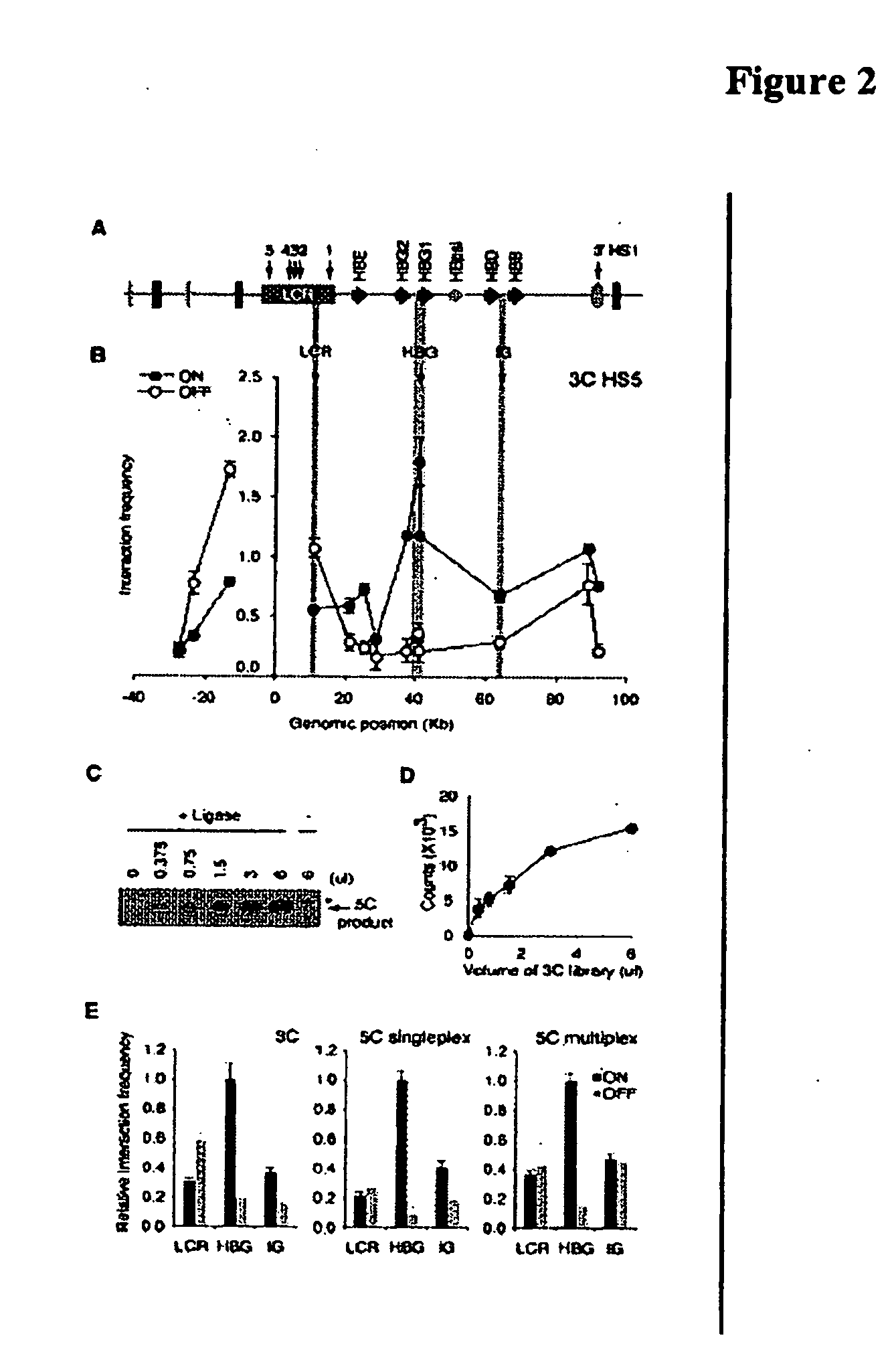Mapping of genomic interactions
a genomic interaction and mapping technology, applied in the field of genomic analysis, can solve the problem that the identification of genes and regulatory elements has only been performed, and achieve the effect of facilitating the identification of genes and regulatory elements
- Summary
- Abstract
- Description
- Claims
- Application Information
AI Technical Summary
Benefits of technology
Problems solved by technology
Method used
Image
Examples
example i
General Laboratory Methods
[0091]BAC selection and control library preparation. A control library for the human betaglobin locus and gene desert regions (ENCODE regions ENm009 and ENr313, respectively) was generated as described (Dekker, J., Nat Methods 3:17-21 (2006); and Miele et al., supra). Briefly, an array of bacterial artificial chromosomes (BACs) covering both genomic regions was mixed, digested with EcoRI, and randomly ligated. In this study, the BAC arrays from the beta-globin locus and gene desert regions were mixed in a 4:1 ratio, to obtain strong signals for the beta-globin locus. Interaction frequencies were adjusted accordingly. The following 7 BAC clones were used for the beta-globin region: CTC-775N13, RP11-715G8, CTD-3048C22, CTD3055E11, CTD-2643I7, CTD-3234J1, and RP11-589G14. A set of 4 BAC clones was selected to cover the 0.5 Mb gene desert region, and include RP11-197K24, RP11-609A13, RP11-454G21, and CTD-2133M23. BAC clones were obtained from Invitrogen and the...
example ii
3C Verification of Human Beta-Globin Locus Chromatin Loops
[0098]The presence of chromatin loops in the human beta-globin locus was first verified using the conventional 3C method. The locus was analyzed in the erythroleukemia cell line K562 and in the EBV-transformed lymphoblastoid cell line GM06990. K562 cells express high levels of epsilon and gamma-globin whereas GM06990 cells do not express the beta-globin locus (FIG. 11). 3C libraries were generated from both cell lines and a control library, which was generated using a series of minimally overlapping BAC clones. Interaction frequencies between the EcoRI fragment overlapping the HS5 element of the LCR and EcoRI restriction fragments throughout the beta-globin locus were determined by PCR. To allow direct quantitative comparison of interaction frequencies determined in K562 cells and GM06990 cells interaction frequencies were normalized using a set of 12 interaction frequencies detected in a control region, a conserved gene dese...
example iii
LMA Detection of 3C Ligation Products
[0102]Detection of chromatin loops in the beta-globin labs was used to develop and optimize the 5C technology. LMA was first performed with a single pair of 5C forward and reverse primers to verify that this method can quantitatively detect a ligation product in the context of a 3C library. A 5C primer pair was designed that recognizes a ligation product that is formed by two adjacent restriction fragments located in the gene desert control region. LMA was performed with this primer pair in the presence of increasing amounts of 3C library (generated from GM06990 cells) and the formation of ligated forward and reverse primers was quantified by PCR amplification with the pair of universal T7 and T3 primers. Ligation of 5C primers is not observed when non-specific DNA is present, is dependent on the amount of the 3C library and requires Taq ligase (FIGS. 2C and D). It was concluded that LMA can be used to quantitatively detect ligation products pres...
PUM
| Property | Measurement | Unit |
|---|---|---|
| melting temperatures | aaaaa | aaaaa |
| volume | aaaaa | aaaaa |
| mass | aaaaa | aaaaa |
Abstract
Description
Claims
Application Information
 Login to View More
Login to View More - R&D Engineer
- R&D Manager
- IP Professional
- Industry Leading Data Capabilities
- Powerful AI technology
- Patent DNA Extraction
Browse by: Latest US Patents, China's latest patents, Technical Efficacy Thesaurus, Application Domain, Technology Topic, Popular Technical Reports.
© 2024 PatSnap. All rights reserved.Legal|Privacy policy|Modern Slavery Act Transparency Statement|Sitemap|About US| Contact US: help@patsnap.com










